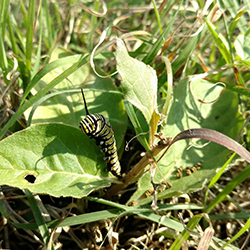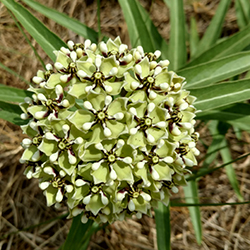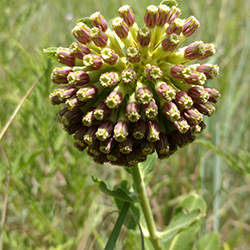Every fall they fly from as far north as Canada to the Oyamel fir forest in Mexico. Their path leads them directly over Texas.
Monarch butterflies are the only species of butterfly that make a two-way cross-continent migration. Every fall they famously fly from as far north as Canada to the Oyamel fir forest in Mexico to escape freezing temperatures. Their path leads them directly over Texas just in time for Saturday’s Monarch Butterfly and Pollinator Festival in Brackenridge Park — a great chance to learn more about monarch butterflies, milkweed, and migration.
You, too, can be a part of one of the most majestic and awe-inspiring events in the natural world by adding fall-blooming nectar plants like cowpen daisy, gayfeather, frostweed, shrubby boneset, and plateau goldeneye to your home landscape to help them on their way.
Monarch larva can only eat milkweed — plants in the genus Asclepias — and the most plentiful fields of milkweed are found in the Midwest. Planting milkweed species in your own landscape is an option, but these native milkweed species are already plentiful in nature.
Here are a few of the most common ones that grow well in the San Antonio area — and are available in some native plant nurseries — providing larval hosts for returning monarchs every spring.

- The most common milkweed I see growing wild along roads, in parks and lawns of unsuspecting homeowners is zizotes milkweed (Asclepias oenotheroides). It can be found growing in the deep soils along the Mission Reach of the San Antonio River and the thin soils of northern Bexar County. Zizotes produces bountiful foliage for voracious monarch caterpillars.The flowers are small but intricate and will appear periodically from spring until fall, whenever the plant receives adequate moisture. It’s the zizotes plant that I visit when I want to find monarch eggs to raise to adults.
 Antelope horn. In the Hill Country proper, antelope horn milkweed (Asclepias asperula)is a common sight along ranch roads. It does great in thin-soil situations, and in extreme cases I’ve seen it growing out of limestone cracks and caliche. In the spring — and fall if the weather is right — large umbels of flowers will attract your attention and a multitude of pollinators. As the seed pods grow and begin to ripen, they take on a distinct curve said to resemble antelope horns. For those living in San Antonio south of the Hill Country, green milkweed (Asclepias viridis) is similar in appearance to antelope horn, but more robust in deeper soil.
Antelope horn. In the Hill Country proper, antelope horn milkweed (Asclepias asperula)is a common sight along ranch roads. It does great in thin-soil situations, and in extreme cases I’ve seen it growing out of limestone cracks and caliche. In the spring — and fall if the weather is right — large umbels of flowers will attract your attention and a multitude of pollinators. As the seed pods grow and begin to ripen, they take on a distinct curve said to resemble antelope horns. For those living in San Antonio south of the Hill Country, green milkweed (Asclepias viridis) is similar in appearance to antelope horn, but more robust in deeper soil.- Texas milkweed. While most milkweeds won’t do well in full shade, Texas milkweed (Asclepias texana)is an exception to the rule. Adorned with delicate bright white flowers, this Hill County endemic is a great plant to include in any shady flower bed. It also looks great in sun!
- Butterfly milkweed. Asclepias tuberosa may be the most colorful of the local native milkweeds. Its bright orange flowers are sure to please both your human and pollinator friends. Another bonus: it’s one of the easier milkweeds to find in the nursery trade.
 One of the more unique looking milkweeds of our area is wand milkweed(Asclepias viridiflora). As its name suggests, it produces zig-zaggy stems up to 3 feet tall. The large clusters of green and purple flowers are sure to catch the eye.
One of the more unique looking milkweeds of our area is wand milkweed(Asclepias viridiflora). As its name suggests, it produces zig-zaggy stems up to 3 feet tall. The large clusters of green and purple flowers are sure to catch the eye.
Note, the milkweed most commonly available in the nursery trade — tropical milkweed (Asclepias curassavica) — is not on this list. Monarchs will definitely use it to lay their eggs on, since it’s the species they evolved on in Mexico. But while it possesses higher levels of the toxins that make monarchs poisonous to predators, it can also foster overwintering colonies that lead to parasitic OE infestations that can be spread to migrating monarchs in spring. This is why tropical milkweed should be cut back every autumn, before the year’s southbound monarchs arrive.
While monarch larva are the most conspicuous users of milkweeds, there are a host of other insects that make use of various parts of the plant. The flowers are magnets for pollinators large and small.
Longhorn milkweed beetle, queen butterfly caterpillars and milkweed tussock moth caterpillars eat the leaves, while black and orange milkweed bugs are a common sight on plants with developing seed pods. Each milkweed plant is a tiny ecosystem, providing habitat for herbivores, predators and nectar feeding insects.
Many people consider milkweed hard to grow, but if you can learn their quirks milkweeds require little to no maintenance (many were seen blooming, unwatered at the height of this year’s record summer heat.) Milkweeds tend to shed their leaves after being planted in landscapes. But don’t fret, the plant is just recouping and will re-sprout when the time is right. I’ve seen plants stay dormant for a whole year after planting.
Also, they tend to lose their leaves throughout the year. Again, the plant will come back when the timing is right. Avoid over-watering native milkweeds, they’re all adapted to the climate of South Texas and tend to do better with neglect rather than pampering.
Each mature plant will produce several seed pods a year. You can collect seeds to share with friends, or let them fly free to spread naturally!




